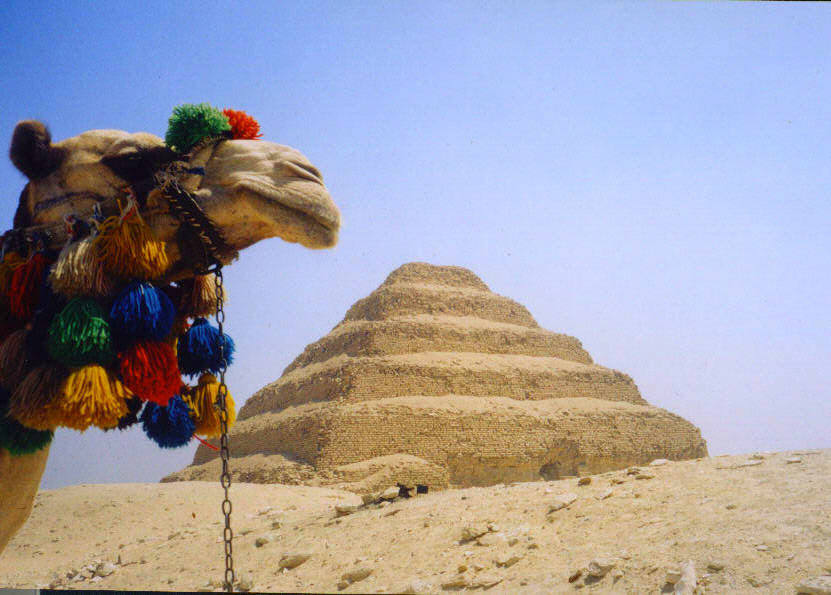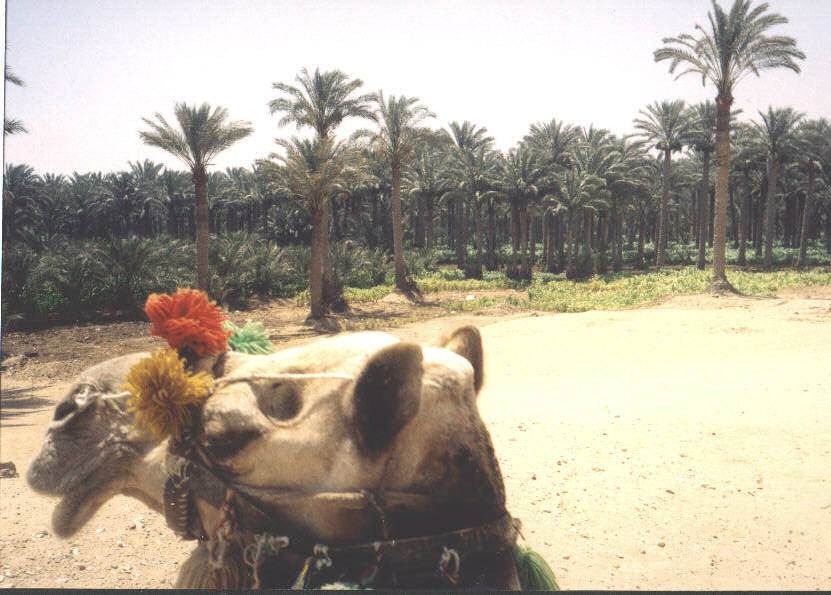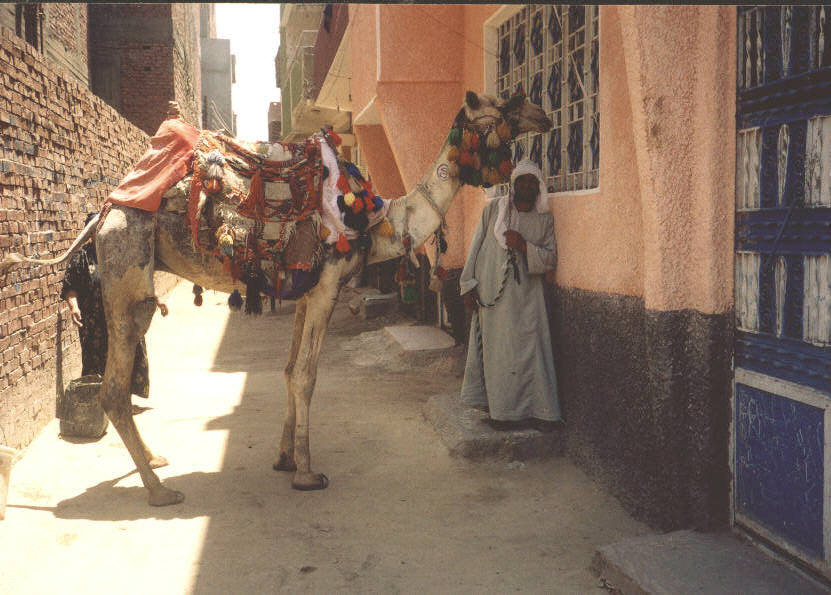
Hop on let me take you to the Step Pyramid
A chance encounter with a Bedouin gives a chance to savour local life and customs of Egypt
One often wishes one knew in advance to make the correct choices, but part of the the thrill of travel is the unexpected, sometime memorable, sometimes not. I have grown to accept both, although I still complain when I get less than what I was promised. Some experiences are priceless, it's only everything-else that you can pay for with a credit card.
I decided to travel to Egypt to observe the rare Transit of Venus across the face of the Sun on 2004 June 8th. Having a tight schedule to see many places in Egypt and not wanting to bother with organizing all of the details, I booked a tour with a travel agent in Colombo. The cost was much less than similar tours being sold in USA, and I could also customize the itenary,
Now looking back, I probably should have only booked the hotels & travel and toured the archaeological sites without any Egyptian tour guide. A guide is useful to point out what one might otherwise miss seeing in a archaeological site. However one can always read a travel book or watch some other guide even if you didn't understand the language.
Some sites like Abu Simbel didn't let the guides in. These sites particularly when not crowded are just fantastic to savor the peaceful environment of the majestic buildings. We were lucky that way in Abu Simbel, one of the best places to visit in Egypt. Egyptian guides to earn their bakshi (Tip) feel obliged to give you a full description of the place, not forgetting to include an often repeated introduction to the history of Egypt. They assume, as is probably true, a majority of the Tourists know nothing about Egypt and must be educated about it's 5000 years civilization. I should have probably asked the guide to cut it short, but didn't want to offend, and hoped that my distracted eyes will convey my lack of interest on a long preamble.
Guides also felt it was important to take one to visit various workshops making Egyptian artifacts or Papyrus wall hanging. Always a free demonstration: how genuine alabaster vases are carved, the ancient art of making Papyrus paper rediscovered not too long ago. One was a school where 6 to 8 year old were being "taught" the art of weaving carpets, which however they will not be able to do in adulthood with larger hands. When I pointed out that importation of products made with child labour was banned they had a long explanation. They had heard the complaint before and had their story-line ready. Each place has it's in-house tourist trap selling items at least 2 to 3 times the market price. There is a long chain waiting for commission from your generous contribution to their economy.
Only paper currency circulate in Egypt. The US$ was worth 6.20 Egyptian Pounds written abbreviated as £E and equal to 100 Piasters. There are 5 Piasters notes worth less than a US penny but I didn't get any. A shop gave me a new 10 Piasters note in change but I didn't see any in circulation. The smallest note to circulate is 25 Piasters. The notes particularly of lower denomination were very dirty since they probably were allowed to circulate for lot longer than they should. Coins were last minted in 1994 and don't circulate. You can buy a packaged set of Egyptian coins in a Tourist shop for 25 times the face value.
Taxis in Egypt are not that expensive. They however feel free to charge Tourists three to four times the meter price. The hotel helps them by giving them a printed sheet with the inflated rates, and probably gets a commission for allowing them to park in front of the hotel. You could get a taxi on the road for about 2 times the meter with a bit of bargaining. I wish I had known to insist on meter when I got in. They probably have that covered and know to bump the meter.
The cheapest mode of transportation are the public and private busses if you can work out which bus to catch. It is not crowded and cost £E 0.5 ( 8 US cents ) per ride independent of the length, One stop or across Cairo. However be warned communication is not always easy, and bus may turn and go in direction you don't guess correctly in advance to get off in time. One must always carry your destinations written large in Arabic and English to confirm the route when you get in the bus. Returning by bus after a late trip to the Net-cafe, the bus took off to the entrance to the freeway within walking distance from my Hotel. It didn't really stop completely when the driver opened the door to let me out. I was lucky to walk away with only a bruise on my elbow. I lost my balance probably because I was also carrying two bottles of water back to the hotel.
One needs many liters of bottled water per day for drinking and even washing ones mouth. They are a good source of income for the hotels which sell it for five times the market price. One is asked only to buy water with tops sealed with a plastic cover, but those sold by the hotel or a large supermarket didn't have the seal. The only faith you were not buying tap water was because that was disgustingly yellow. Minerals dissolved in the water the hotel book explained. It was clearly rust from the plumbing since it turned a lighter yellow after the tap was left running for sometime.
Despite all precautions most tourists I was told get diarrhea within few days of coming to Egypt. For Japanese tourists it is few hours. From a group of over 30 American tourists from Louisiana we met on the Nile cruise only 4 were OK, few days into the trip, although they had followed all of the precautions and had eaten only in 5-star restaurants. I was glad to be more adapted for Third world travel.
The last day was free, and was allocated for shopping. The recommendation was that No Tourist should go away without buying from the Khan al-khalili bazaar in Cairo. I had already purchased the few items intended to take back and was not too motivated to visit another tourist market place however famous. I decided instead to visit Saqqarah about 20 kms south of Giza. I would try the bazaar in the evening if time permits but I never did make it there.
The Pyramid Cataract hotel I was staying is on the road from Giza to Saqqarah. As an optional tour the travel agent wanted $30 per person (a 2 person minimum) with guide. The Hotel wanted $30 for a Taxi for the round trip with an hour visit. So I walked out of the hotel and caught the first bus that came past. The driver had given a nod when I asked for Saqqarah. However I soon found out that was the Saqqarah village and not the "Tourist site" with Step Pyramid. Instructed by a passenger who spoke English, I was dropped off at the turn off to the archaeological site.
There were two security guards who saw an opportunity. Salaam-aliqqum they said. Aliqqum-aw-Salaam I replied and asked how far it was to the Pyramid. I was told 2 kms. So I waited to try hitch a ride. A van stopped. The security guard negotiated to get me a ride. He insisted I pay £E 4 which I gave without objecting. He kept his commission and gave the driver something to take me. The driver dropped me at the entrance. I went to the Ticket counter and paid £E 20 ($3.25) entrance fee which is almost standard for all Egyptian monuments. I am asked for £E 2 extra for what I first heard as Tax. That is new one I thought, but then understood that was the charge for the Taxi to enter. I said I had no Taxi and asked how far it was to the site. I was told it was 0.5 kms more, but by this time the van that brought me had turned around and gone back.
So with no option I said I will walk to the Pyramid site. Few minutes after I left, a man came past on the bicycle and got down next to me. He started talking, asked me where I come from which seems to be the most frequently asked question from tourists. I always replied Sri Lanka, and most have heard about it, for the good tea. They always pretended to know, but I did catch a few by asking them to tell me where it was. I said I had come by bus since a taxi cost £E 75 each way which he agreed was too much. One of the highlights I wanted to see at Saqqarah were the tombs of the Apis bulls. He told me that they were closed renovation. When we got close to the site I offered some bakshi which he refused to my surprise. It was then that I realized he was a security guard sent to accompany the crazy tourist wanting to walk on to the site. I therefore let him introduce me to his friend a guide, who I know will return a commission. This guide showed me around the Pyramid of Ti and the tombs of Ptah-hotep and Mereruka. He kept asking me if I wanted to take photographs which was clearly marked as banned, saying it was OK. I said I was not interested. I presume it was security to ensure more bakshi. At the end of the tour when I gave him £E 10 as bakshi he insisted on £E 20 which I obliged, although I was running short of £E cash by then.
Just outside one of the security guards was on a camel and I found that interesting and went over to take a photograph of him with the Step pyramid in the background. A Bedouin who spoke English was looking for a tourist to take for a ride, approached me and offered to take me around the site on his camel. He asked for £E 80. which was more Egyptian money than I had then with me, so I showed him that I had only £E 65 and offered £E 40 to which price he agreed. A camel costs £E 4000 (US$650) so 1% for a ride seemed to me fair price. Since most tourists come by Taxi he probably had limited customers particularly in June which was not high season. Most tourism to Egypt is in winter when it is lot cooler.

I took a few photographed next to the decorated camel he called Sam and climbed on. Riding the camel was smooth at the slow pace with the Bedouin walking in front. The Bedouin was free to take the camel outside the area to which tourists are restricted, and the view walking around and close to the Step pyramid was great. The camel added a lot of character to the photographs. We then stopped for a photo stop. The Bedouin insisted that I switch head gear with him for the photos. The Bedouin had worked out a series of poses and I followed his direction. Finally he asked me to stand-up on the camel. He may have been joking, but I was not going to refuse the challenge. It was clearly impossible without some support so I got his stick and stood up with a lot of faith the camel will not move while the owner was relaxed taking his time over the photography. I am glad the narrow and high platform was more stable than the bus I had experienced the previous night.

He took me close to the monuments next to the Step pyramid and gave me time to explore the interesting ruins. Returning to the camel I asked him to get on the camel as well so we could go at a proper pace. Now the ride was lot faster and far more bumpy. I don't think the camel appreciate the added weight and made his feeling know with some loud exhaust. It was lucky that we were moving forward at a good pace. The Bedouin politely invited me to visit him the next time I came to Egypt. Curious and wanting to visit a home I asked the Bedouin to take me to his place straightaway. He pointed out his place in the distant horizon probably about a mile away and agreed. We left on a long ride across an oasis and through the adjoining Saqqarah village.


Finally we got to his home, which was not a tent but looked like a lower middle class home. The camel was tethered to the grill in front of the house and we walked in leaving our sandals at the door. He offered me a strong cup of tea, which I suspect could not have dissolved more sugar in it.
He lived on the ground floor of building with his wife, He invited me to see the two upper floors he was building for his two grown sons. He gave me house sandals to wear. The rooms had been built but the top floor still had no roof. To not waste space while under construction it was being used for his livestock. There were baby chicks in one room and pigeons in another. The top floor had ducks and even a large turkey which took me by surprise. When that floor gets a roof I was told the livestock will go on the roof top. The house I am told is never completed, since it is only then that the owner has to start paying taxes on it.
Returning to the living room we relaxed. I could hear his wife preparing a meal. He showed me photographs taken with various tourists who had visited him. He didn't show any standing on the camel so I guess no one else took him up on the wild suggestion. He clearly expected me to post him photographs and gave me his address. We took a few more photographs after he put me in one of his galabaya. I had soon finished the 2nd roll film I had with me.
His two sons dropped in and said hello. One had heard about Sri Lanka as the land of Adam's Peak and the footprint. I had known of the association but always felt that was more a story adopted by Sri Lankan Muslims. I didn't expect to hear it from a Bedouin in remote Egypt. It is probably identified in modern textbooks which translate the stories in the Koran.
I tried to get him talking on politics, but all gathered was that he identified all four leaders Osama, Saddam, Bush and Blair as power hungry and not working in the interest of humanity. They feel that Saddam let down the people of Iraq by not surrendering when he could have gone to exile. They felt Allah didn't consider him worthy of a death of a Martyr. An interesting explanation to Saddam's surrender when caught hiding in a hole.
The meal took over 2 hours to arrive steaming hot in one large dish with 4 spoons. The wife's brother and son joined us for the meal in traditional Bedouin style. It was rice and chicken with something probably egg-based under the rice. It was by far the best chicken buriyani I have had for a long time. I was ignoring health risks deciding I was probably taking as much risk eating in the hotel although that one assumed was OK. I probably picked up the necessary digestive organisms since I felt far better for the rest of trip after being sick in Alexandria a few days previously.
It was time to go. I gave him all the £E I had with me keeping just enough to catch a bus back to the hotel. He sent his son with me in the first bus to ensure I got on the correct bus after that got me to the main Saqqarah-Giza road.
I remembered that my son Rhajiv after watching the travel channel had recommended that I meet up with a Bedouin and have lunch at his home. I never expected to do it. I would not have got the opportunity if I didn't strike out on my own, independent of the Egyptian travel industry. I can now look back with fond memories of meeting a Bedouin, and having a meal with him off the beaten tracks of a camel ride to the Pyramids.